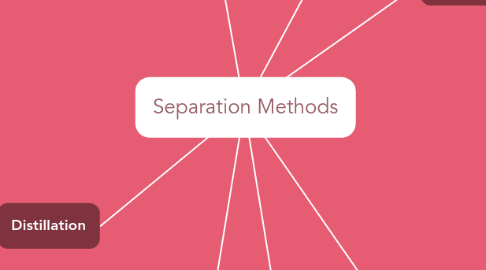
1. Magnetic Attraction
1.1. Seperates magnetic and non-magnetic substances
1.2. Steps
1.2.1. A powerful magnet is used to separate iron from other materials in a junkyard
1.2.2. When the magnet is switched off, iron is dropped into a collection of bin. The metals are then sold and brought to recycling centres
1.2.3. Iron is reused in new objects
2. Distillation
2.1. Distillation
2.1.1. It separates a solvent from a (soluble-solid and solvent) solution
2.1.1.1. This is due to substance that have different boiling points which allows distillation to separate the substances, substance with the lower/lowest boiling point in the mixture charges into gas state and Condense to cooler surface
2.1.2. Steps
2.1.2.1. The solution on distillation flask is heated until it boils.
2.1.2.2. Liquid changes into gas state which passes through the condenser. The condenser has cold water running through it continuously.
2.1.2.3. The gas cools and condenses into pure water, which is called the distillate. The solute present in the solution remains in the distillation flask.
2.2. Fractional Distillation
2.2.1. It seperates solvent from a (liquid-liquid) solution
2.2.1.1. Liquid from mixture of substance of solvents with different boiling points are obtained
2.2.2. Steps
2.2.2.1. The solvent with a lower boiling point than the other solvent changes state into gas and rise up the fractionating column as the solution is heated
2.2.2.2. The gas condenses in the fractionating column and falls back into the flask
2.2.2.3. The solvent with a lower boiling point than the other solvent, reaches the upper part of then column and is distilled over, first.
2.2.2.4. At this stage, the thermometer shows a constant temperature of (boiling point), which is the boiling point of the solvent with a lower boiling point
2.2.2.5. In this condenser, hot gas loses thermal energy to the inner surface of the condenser with running water and condenses into liquid that flows down the inner tube of the condenser and into the receiver
2.2.2.6. The condensed gas, is collected as the distillate in the receiver.
2.2.2.7. When all the distillate has distilled over, the temperature rises rapidly to (boiling point of the solvent with higher boiling point), which is the boiling point of the solvent with a higher boiling point. At this temperature, water distills over and can be collected separately.
3. Crystallisation
3.1. The solvent changes from a liquid to a gas at a much lower temperature
3.1.1. Rapid cooling produces small crystals while slow scrolling produces large crystals
3.1.2. Separate solute from solvents that decompose on heating (pure soluble solids samples)
3.2. Steps
3.2.1. Higher
3.2.1.1. Heat till saturation
3.2.2. Chinese is
3.2.2.1. Cool to allow crystals to form
3.2.3. For
3.2.3.1. Filter to collect crystals
3.2.4. Worthy
3.2.4.1. Wash crystals with cold distilled water
3.2.5. Dorks
3.2.5.1. Dry crystals between piece of filter paper
3.3. How? (Application)
3.3.1. The solution is HEATED to remove most of the solvent. Heating is stopped when a saturated solution is formed
3.3.2. The hot, saturated solution is allowed to COOL. The dissolved copper (ii) sulfate to cool as pure crystals.
3.3.3. The crystal formed are collected by the FILTRATION. The residue of pure crystals is WASHED with cold distilled water. The crystals are then DRIED by pressing them between pieces of filter paper.
4. Filtration
4.1. Steps
4.1.1. A mixture ____ and ____ is pored onto filter funnel that is lined with wet filter paper
4.1.2. The pores of the filter paper allows the smaller particles to pass through them. The larger particles that cannot pass through the pores because of its size, are retained by the filter paper.
4.1.3. The solid that is left on the filter paper is called the residue. The liquid that passes through the filter paper is called the filtrate
4.2. Separates substances with different particle sizes
5. Evaporation till Dryness
5.1. Separate dissolved solutes
5.2. Make use of the fact that the solvent [liquid] in a solution can evaporate at any temperature, leaving behind a residue of the solid [soluble solid] that was dissolved in the liquid.
5.3. Steps
5.3.1. Heat is applied to the solution. This increase the rate of evaporation.
5.3.2. Water changes state at a lower temperature than salt. Thus, salt is left behind as the residue.
6. Chromatography
6.1. Used to separate small amounts of substances that dissolve to different extents in particular solvent
6.1.1. Since different substances in a mixture dissolve to different extents in a solvent
6.2. Steps
6.2.1. Place a spot of food colouring on the paper
6.2.2. Dip the paper into a solvent such as ethanol or water. *Ensure that the coloured spot is above the solvent level
6.2.3. The components will separate as the solvent travels up the paper
6.3. Substances that are more soluble in the solvent travels a longer distances from the starting point. Substances that are insoluble in the solvent that are insoluble remains at the starting point.
7. Sublimation
7.1. Separates a mixture of solids, one of which sublimes
7.1.1. Particles at surface of solid have energy to break free from solid and escape as gas
7.2. Steps
7.2.1. A few substances change directly, from solid to vapour/gas upon heating without going through the liquid state.
7.2.2. Water vapour cools and condenses into solid directly when in contact to cooler surface
7.3. E.g.
7.3.1. Iodine
